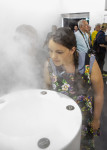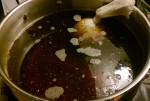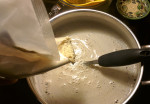 I have never been much into beer. I had tried it a number of times but it never made sense to me. This all changed few years ago (2014) when we decided to travel to Ireland. I was not about to go to Ireland and not sit in a couple pubs and have a not few pints of Guinness. Sorry if that sounds a bit chiché, but I was going to have the full experience. So… I started training my tastebuds (at least that’s what I told my wife). I brought some Guinness home to get an idea what might be in store for us. To my surprise, it wasn’t bad.
I have never been much into beer. I had tried it a number of times but it never made sense to me. This all changed few years ago (2014) when we decided to travel to Ireland. I was not about to go to Ireland and not sit in a couple pubs and have a not few pints of Guinness. Sorry if that sounds a bit chiché, but I was going to have the full experience. So… I started training my tastebuds (at least that’s what I told my wife). I brought some Guinness home to get an idea what might be in store for us. To my surprise, it wasn’t bad.
When we got to Ireland, we went to the Guinness brewery. This was the eye opening experience I needed. It’s an excellent tour. They cover all aspects of the beer making process, but they go deeper. My ah Ha! moment came in their smelling room. It was a white room which had no apparent light source. It had various stations tubes which were emitting what looked like smoke. Each tube had a scent, a different aspect of the various smells and flavors in the beer. I got it. Ohhh this is what I am tasting.
 Since then, Guinness has still been a favorite. I found that it’s not that I didn’t like beer so much as I didn’t like the watered down crap at the grocery store. I am learning that I like darker, more complex flavors. I like to cook and have a propensity towards layers and depth of flavor, so perhaps the beer thing is understandable. I seem to have settled into Stouts, Porters, and some IPAs. About a half year ago I came across Northern Brewer. They sell kits to make craft beers at home. They had a great set of videos explaining in great detail how to brew their beers. I was sold. I asked for the White House Honey Porter kit for Christmas, and my wife was kind enough to get it for me. My son-in-law got me a book called How to Brew. (update: A Very good book. I recommend it. It’s written in layers. He provides a base layer of information, then starts over and lays in more and more details. It’s nice because you get the process and which point one can get as deep as one wants by continuing through the rest of the book. 04-02-17).
Since then, Guinness has still been a favorite. I found that it’s not that I didn’t like beer so much as I didn’t like the watered down crap at the grocery store. I am learning that I like darker, more complex flavors. I like to cook and have a propensity towards layers and depth of flavor, so perhaps the beer thing is understandable. I seem to have settled into Stouts, Porters, and some IPAs. About a half year ago I came across Northern Brewer. They sell kits to make craft beers at home. They had a great set of videos explaining in great detail how to brew their beers. I was sold. I asked for the White House Honey Porter kit for Christmas, and my wife was kind enough to get it for me. My son-in-law got me a book called How to Brew. (update: A Very good book. I recommend it. It’s written in layers. He provides a base layer of information, then starts over and lays in more and more details. It’s nice because you get the process and which point one can get as deep as one wants by continuing through the rest of the book. 04-02-17).
I watched the Northern Brewer videos as well as read through the instructions several times. There is always a huge difference between book knowledge and doing knowledge. At some point, you just have to step off the ledge and give it a go.
The Experience:
 Similar to my Guinness experience, I wanted to get the full understanding of each character in play, so I took the time and smell and give some thought about what was going on. The specialty grains were nice. They smell sort of like a natural foods store sort of a sweet hay with hints of chocolate. My mother-in-law said it smelled like peanut butter (which I could smell once she said it). I put the grains in the muslin bag. This was then placed in the cool water. I started heating the water on full heading towards a boil. The warm water and grain smells a little bit like vegetable barley soup. It’s actually quite nice.
Similar to my Guinness experience, I wanted to get the full understanding of each character in play, so I took the time and smell and give some thought about what was going on. The specialty grains were nice. They smell sort of like a natural foods store sort of a sweet hay with hints of chocolate. My mother-in-law said it smelled like peanut butter (which I could smell once she said it). I put the grains in the muslin bag. This was then placed in the cool water. I started heating the water on full heading towards a boil. The warm water and grain smells a little bit like vegetable barley soup. It’s actually quite nice.
 The water was getting warm and I was a couple minutes away from needing to remove the grains. I started prepping my next step which was the first layer of hops, and the malt. The initial hops Chinook had a crazy strong scent. It was strong, like an ipa on steroids. The malt didn’t have much of a smell at all. After the 10 minutes was up I pulled the grain bag and strained it (putting the drippings back into the boil pot). I reduced the heat and added the hops and malt. This made the mixture very thick for a few minutes until I got it all mixed together. I brought the mixture back up to a boil watching to make sure it did not boil over (which was warned about in the instructions). It came close to boiling over, but reducing the heat settled everything out. The hops smell was very intense for a couple minutes, at which point it relaxed into a sort of chocolate milkshake(ish) smell. I’m thinking the milkshake vibe comes from the malt. After roughly 5 minutes I reduced the heat to keep it at a boil, but not be so intense as to lose too much water (I do want some beer at the end of all of this).
The water was getting warm and I was a couple minutes away from needing to remove the grains. I started prepping my next step which was the first layer of hops, and the malt. The initial hops Chinook had a crazy strong scent. It was strong, like an ipa on steroids. The malt didn’t have much of a smell at all. After the 10 minutes was up I pulled the grain bag and strained it (putting the drippings back into the boil pot). I reduced the heat and added the hops and malt. This made the mixture very thick for a few minutes until I got it all mixed together. I brought the mixture back up to a boil watching to make sure it did not boil over (which was warned about in the instructions). It came close to boiling over, but reducing the heat settled everything out. The hops smell was very intense for a couple minutes, at which point it relaxed into a sort of chocolate milkshake(ish) smell. I’m thinking the milkshake vibe comes from the malt. After roughly 5 minutes I reduced the heat to keep it at a boil, but not be so intense as to lose too much water (I do want some beer at the end of all of this).
 I let it perk along for 40 minutes at which point the instructions had me remove the heat add the honey and a second hopping. This next batch of hops was a German Hallertau. It was very pleasant smell. Sort of like a more delicate hops decorated with a Christmas tree.
I let it perk along for 40 minutes at which point the instructions had me remove the heat add the honey and a second hopping. This next batch of hops was a German Hallertau. It was very pleasant smell. Sort of like a more delicate hops decorated with a Christmas tree.
 As I have been reading, one topic of which there has been a huge amount of emphasis, is sanitization, and it is the point where I nearly tripped up. The process of beer making is actually a war of micro organisms and their food supplies. You want certain things to grow but not others. I poured the honey into the boil pot, I then used some of the hot wart water to get the rest of the honey out. This would be fine in standard cooking, but the jar was not sanitized and some of the liquid touched the outside of the jar. I am sure it’s pretty clear at this point I am not an experienced brewer, and it’s possible this little of a slip may have been perfectly fine, but I didn’t want to take any chances and brought the wart back to a boil. I let it go for a couple of minutes, and then I put the pot into an ice water bath.
As I have been reading, one topic of which there has been a huge amount of emphasis, is sanitization, and it is the point where I nearly tripped up. The process of beer making is actually a war of micro organisms and their food supplies. You want certain things to grow but not others. I poured the honey into the boil pot, I then used some of the hot wart water to get the rest of the honey out. This would be fine in standard cooking, but the jar was not sanitized and some of the liquid touched the outside of the jar. I am sure it’s pretty clear at this point I am not an experienced brewer, and it’s possible this little of a slip may have been perfectly fine, but I didn’t want to take any chances and brought the wart back to a boil. I let it go for a couple of minutes, and then I put the pot into an ice water bath.
From this point I have no pictures of the transfer process and it requires a person with at least 4 or 5 hands. Having only 2 hands, I used both hands to pump the syphon, but I needed one hand to keep the hose in place, and another hand to keep the syphon roughly an inch off the bottom of liquid and out of the trub (all the beer makings which have settled to the bottom). The hose leads down to a Carboy (the vessel where the fermentation takes place). This sits on a chair in front of the counter top, so the gravity of the liquid forces the flow of the syphon. The length of the hose quickly became a problem. When I pumped the syphon, the hose lifted out of the carboy sending liquid onto the chair and floor. I grabbed a cardboard box as it was the only thing sitting close enough to help with my emergency. This helped but didn’t solve it completely. I had to keep a close eye on the hose so it wouldn’t hop out again. The other issue was the tip of the syphon dipping into the trub. Once a good portion of the wart was in the carboy, it’s hard to get enough depth to keep everything flowing. If you lift up, you get air which means the flow stops. If you have to pump to get it to flow again, you bounce the tip around a lot which means you are getting the trub nastiness in the beer it’s a fight at best.
Once all the wart was in the carboy, I added half the yeast package as per the instructions. It was a guesstimate as there’s not really a good way to measure it (as you could potentially add contaminants). You have to eyeball it. I am not too worried as this is what Norther Brewer does in their videos as well. I gave it a good shake. This adds a little extra oxygen to the wart as yeast needs oxygen to thrive. I then I put the lid and airlock on the carboy and set it in the corner of our kitchen.
The next morning, I checked it and sure enough, it was bubbling. Now it’s a waiting game. This is not an easy thing for me as I am a tweaker by nature. Hands off is not… well I am keeping my hands off. I will write more once I get into bottling.



















